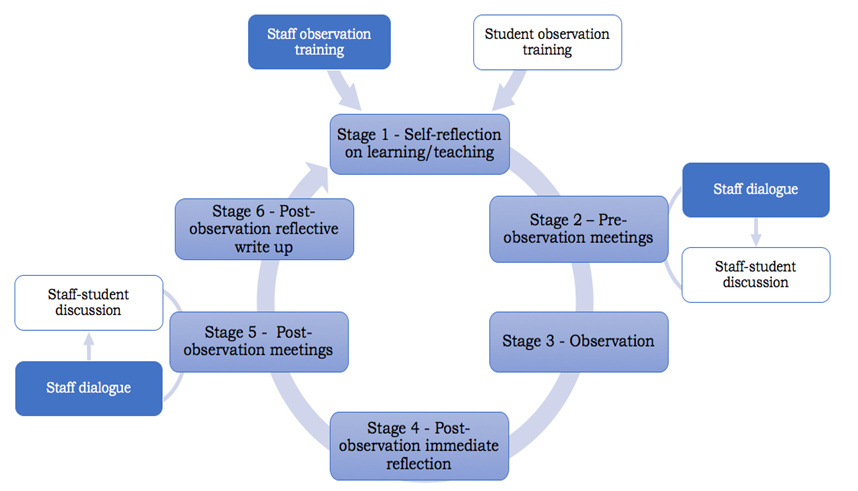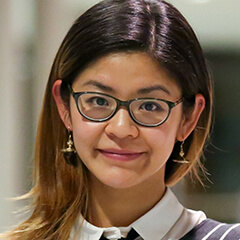26 June 2024
Enhancing learning and teaching quality through staff-student collaborative observation: Learning from praxis1

Author
Dr Vanessa Cui
Birmingham City University
The ‘Enhancing learning and teaching quality through collaborative observation’ project, funded as part of QAA’s Collaborative Enhancement Projects, has been working with students and staff members at Birmingham City University, Loughborough University and University of Wolverhampton over the last fifteen months. Drawing on reflections from participants and focus group discussion between the researcher and participants, this blog focuses on what we’ve learned about participants’ experiences of collaboration through the Cycle of Collaborative Observation (CoCO) (O’Leary and Cui 2020) - an approach designed to facilitate authentic and meaningful staff and student collaborations for quality enhancement.
Our project has involved eight case studies from a range of subject areas across undergraduate and postgraduate taught programmes including healthcare education, business studies, marketing, computer science, psychology and higher education. The profiles of participants illustrate the diverse bodies of staff and students in our HEIs, they include home and international students, undergraduate, Masters and PhD students, mature students, students and staff members from different ethnic groups and staff members at different stages of their academic career with different academic profiles (academic tutors, professional practices teaching, teaching and research).
In our previous blog post, we shared emerging findings from the case studies about the value of building pedagogical relationships and how participants of the project felt the impact of the collaboration observation on their developing relationships. After two cycles of collaboration observations, it is clear to all participants and the project team that meaningful development of pedagogical relationships between students and staff takes time and requires facilitation and scaffolding.
Within the cycle itself (see Figure 1 for CoCO), the various stages where participants come together to discuss learning and teaching are crucial to this process. The discussions open the dialogues and the spaces for students to become aware of their teachers’ pedagogical intentions, to see and to get to know their teachers as someone they can talk to, and they can work with on issues/questions/challenges they face in learning. For the teachers, there are valuable opportunities to get to know their students and build trusting relationships. During two recent focus groups between case study teams and the researcher, students and staff members reflected on their experiences of the two cycles and suggested that pre-observation meetings are a really important step to establish and nurture their collaborative relationships. Based on their experiences from two cycles of observations, participating teachers and students revealed that the supportive and open environment was key to students developing the confidence to ask questions and sharing their perspectives without the concern or fear of being judged. In particular, students and teachers valued the opportunities for students to share their insights about how they approach learning during sessions and to give suggestions on learning activities they feel would be more suitable for their class. When asked about what they think facilitated dialogues between students and teachers, participants commented on the importance of using “open questions” and giving “spaces for each member to talk”. The students felt “lecturers showing their interests in my perspectives” was key to developing their confidence.

Figure 1: Cycle of Collaborative Observation (CoCO)
Our case study participants also reflected on how their collaboration developed over the two cycles. In one focus group discussion, students and lecturers talked about how cycle 1 discussions were mainly focused on the technical and practical aspects of the ‘observation’ (i.e. who would observe what, how to take notes, what each observed saw) whereas cycle 2 discussions “had more depth” and “students contributed more about their views on the activities”. This view was shared across several case studies. Some students felt that as they progress through their degree, they became more mature in their views about being a learner at university, the collaborative observation project has offered them the opportunity to discuss, share and reflect their perspectives with their peers and lecturers.
Observation as a method for inquiry is best suited for long-term, qualitative work as the detailed observation notes build over time. Using it as part of a student-staff pedagogy collaboration means the observations themselves need multiple occasions to generate meaningful data to support discussions between participants. All participants recognise that to utilise the intended benefits from a new pedagogical model and approach, such as CoCO, and to achieve their intended outcomes, ample time is needed for participants to learn, practice and reflect on its implementation in their own contexts. While it is possible, as demonstrated by a couple of the case studies in the project, for students and staff to carry out two cycles of observation over one academic year (in both cases they are postgraduate programmes); the demands on our students and staff’s time and the potential challenges of timetabling all the activities across a cycle of observation mean that it is often the case that a cycle of observation happens in one academic year.
How can CoCO can be implemented at scale?
There are two ways to consider this. Certainly, across a programme, multiple pairings of staff and student observation teams can run alongside of each other. With careful planning, this model can contribute to course wide quality enhancement activities. What we need to be mindful of is that CoCO is underpinned by pedagogical principles and approaches to develop higher education students’ and teachers’ situated learning (Lave and Wenger, 1991), critical reflective learning (Brookfield, 1995) and their collective consciousness (Bowden and Marton, 2004). As revealed in this blog, the key qualities about this collaborative approach are developing relationships among learners and teachers and building situated understandings about learning and teaching over time. This is where the meaningful student feedback on learning and teaching grow.
The second way to consider ‘scaling up’ CoCO is how the collaboration can develop into other areas of quality enhancement work. From four case studies, we learnt how the collaborative observation work and findings enabled the case study teams to create further student-staff collaborations and to gather meaningful feedback from wider student bodies. For example, two case studies invited student inputs to their cycle two learning and teaching session topic and content from their wider cohort based on feedback from student observers in cycle one. The collaboration between students and staff in these cases give staff insights into students’ learning experiences, as well as the experiences and confidence to carry out wider collaboration with students on the programme. One staff member commented that, for them, “this is the next step of student-staff collaboration on teaching and learning”. Another case study used the collaborative observation as an opportunity for student observers to engage with their peers, using the observation and discussion data to inform student peer-to-peer discussion and feedback on learning and teaching. Both students and staff felt that this has really enhanced the meaningfulness of the student feedback activity with the wider cohort. Indeed, across all case studies, participants recognised how CoCO facilitate students developing a much deeper and more appreciative understanding about feedback on learning and teaching. All student participants mentioned that when they fill in evaluation surveys now, they look to share meaningful insights with their teachers about their learning experiences and how teaching and learning in their programme impacts on their experiences. Staff really value the opportunities to discuss student feedback as part of the collaboration. This also addresses an issue staff face with survey type of student evaluation feedback data where the information is very brief, often with no context and its usefulness to inform situated practices is often limited.
Acknowledgements: I’d like to thank the participants of the Enhancing learning and teaching quality through collaborative observation project for their insightful reflections and discussions about their experiences of using CoCO to facilitate staff-student collaboration for learning and teaching quality enhancement.
1 Praxis here is underpinned by practice theories and research (see Kemmis 2010). In essence, we frame and conduct CoCO as an education practice that involves conscious, self-aware and critical reflective actions and reactions. Seeing staff-student collaboration on teaching and learning in this way, the key focuses are on the interactions, relationship building and meaning making activities rather than the products/outputs of the ‘work’. This is about making sense of ‘knowing what one is doing in the doing of it’.
